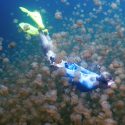They feed on the blood they suck from their prey. Animals and juicy humans like you are in these deadly insects’ diets. They’re also called assassin bugs, for a good reason. And now your house is infested with them. So what are you going to do?
Kissing bugs are dark in color. They can be brown or black and have red or orange spots on their wings. They are about 2 cm (.75 in) long and have cone-shaped heads. Although their name might sound cute, they earned it because they bite humans around the mouth, like a kiss.
Or rather a deadly kiss, as they carry the parasite that causes Chagas disease. It can cause a severe infection that could eventually kill you. Where in the world can kissing bugs be found? Which life-threatening condition could you develop decades after the bite? How could you prevent the parasite from entering your body?
Step 1. Beware of Bloody Bed Sheets
Kissing bugs are active at night. So the chances are that you won’t notice their presence in your house until you have an infestation. They tend to bite people in their sleep, so mattresses and pillows are the first places they’ll infest. Blood on your sheets warns you they’ve moved in. Their bites are painless, and you may see patches of them like hives around your mouth. To reduce the swelling, clean the area with water, apply ice and a first aid antiseptic to minimize any itching.
Step 2. Don’t touch the bite
Luckily, everyone bitten by the murderous kissing bug will not get Chagas disease. The infection comes from their feces, not the bite. After the insect feasts on your blood, it will poop. If the feces enter your body through your mouth, nose or eyes, you’ll get infected. Another way the dung enters your skin is if you scratch or touch the bite.
Step 3. Don’t let your guard down
In the United States, more than 300,000 people host the parasite that causes Chagas disease. But in Mexico, Central and South America, the number goes up to 8 million. And you can encounter them in other places. In Delaware, U.S., a kissing bug bit a young girl on the face. Her family did the right thing and called the public health authorities. Fortunately, the girl didn’t have other symptoms. This was the first time authorities identified a kissing bug in Delaware. Wherever you are, beware of these deadly kissers.
Step 4. Get medical help
If you get infected with the parasite that causes Chagas disease, the first few weeks are the infection’s acute phase. You’ll probably get mild flu-like symptoms, and you’ll feel better as the number of parasites in your blood decreases. But you’ll still have parasites in your body, even if you don’t have any symptoms. This is the chronic phase of the infection.
Up to 30% of people with Chagas disease experience life-threatening symptoms even 10 to 25 years after the bite. You could have an irregular heart rhythm, an enlarged heart or a widened esophagus. Once it gets to the chronic phase, there’s no cure for the disease. So you’ll need to get treated early. If you think these bugs have kissed you, get medical treatment right away.
Step 5. Catch them
If you want to get rid of the infestation yourself, you can catch the bugs as you see them. Use a container so you won’t have to touch them directly. Make sure you clean the area with bleach or an insecticidal solution.
Always check your pets when they come inside. If they have bugs, wear heavy-duty gloves to remove the insects.
Well done. You survived a kissing bug infestation. But put the insecticide down because it doesn’t work well on this next tiny bloodsucker that’s infesting your home. But don’t worry. We can help you get rid of those too here on How to Survive.
Sources
- “Kissing Bugs & Kissing Bug Bites“. 2022. Webmd.
- “Everything You Need To Know About Kissing Bugs And Their Bites”. 2022. Healthline.
- “This ‘Kissing Bug’ Case Raises Alarm For Summer“.Jacqueline Howard and Nadia Kounang, CNN. 2022. CNN.
- “NPR Cookie Consent And Choices“. 2022. Npr.Org.
- “CDC – Chagas Disease – General Information – Vector Information“. 2022. Cdc.Gov.

















